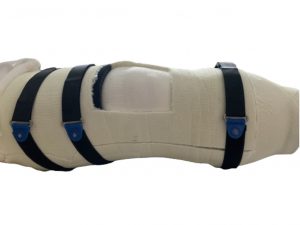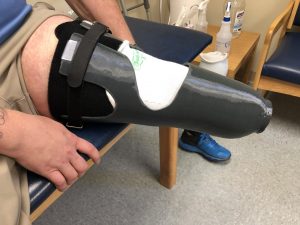
Led by Thomas Walsh, Abilities In Motion has been leading the way with Immediate Postoperative Prosthesis (IPOP) procedures since 1995. Thomas was a pioneer in designing a removable immediate post operative cast or prosthesis. This unique, previously unavailable service and course of treatment has become preferred by doctors for individuals facing below the knee amputation.
After the surgeon has completed their work, our staff provides a removable cast that protects the incision site, reduces swelling, decreases pain and allows the physicians to conduct regular inspections of the residual limb.
In some cases, a temporary prosthesis can be attached to make it possible for some patients walk weeks after surgery.
Below are some quick facts about the procedure followed by an academic article that was published in the Journal of Prosthetics and Orthotics by Abilities In Motion’s own Thomas Walsh. If you have any questions, please contact us live chat (below), by phone: (513) 245-0253 or by email.
Benefits of an IPOP
- The system is custom fabricated with strategically placed gel pads for proper pressure distribution.
- The system is adjustable to compensate for decrease in limb size during healing.
- The IPOP is removable for wound inspection.
- The IPOP is made with a fiberglass shell to protect the residual limb in case of a fall.
An IPOP will:
- Immobilize the wound to improve healing.
- Control edema.
- Avoid knee flexion contractures.
- Protect the incision from extrinsic trauma.
- Improve healing rate. Studies report that with the use of an IPOP, in conjunction with an amputation level xenon clearance, healing levels approached 100%. Prior to the use of immediate post operative prosthesis, the primary healing rate ranged from 62% to 75%.
The History of Immediate Post Operative Prosthesis
- The IPOP procedure originated in the late 1950’s.
- Studies report with the use of an IPOP, prosthetic rehabilitation improved from 64% to 100% for unilateral amputees who had been ambulatory before amputation.
- Initially the IPOP was not easily removable, but in 1995 at the request of surgeons, Tom Walsh, CPO, LPO, FAAOP designed the removable IPOP.
- This removable system was published in the Journal of Prosthetics and Orthotics, October 2003, Volume 15, Number 4.
3D Printed IPOP
With the use of a smart device and scanning application, Abilities In Motion is now able to scan the patient’s residual limb and fabricate a 3D printed IPOP. This design is lighter in weight and easier to apply.

